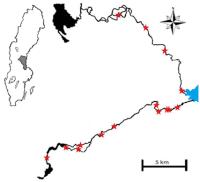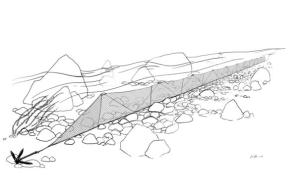Method
Study sites

The study was performed between the 6th of June and the 10th of October 2012 in Gävleborg County. The investigation sites were located in the two streams Gavleån and Testeboån, which both empty into the Bay of Gävle. The Bay of Gävle is located in the southern Bothnian Sea.
Sample method

Fish were sampled with Nordic multi-mesh Stream Survey Net (NSSN). The NSSN uses the same multi-mesh principle as the Nordic net; both the mesh size of the panels (12 panels with mesh size from 5 to 55 mm mesh side) and their sequential order are identical. The fishing height of the net is 700 mm. The length of the 12 sections is 1,500 mm each, resulting in an efficient length of 18 m and an efficient surface of 12.6 m². The nets were set between 6 and 8 pm and lifted between 6 and 8 am the day after. The nets have been put in to the water parallel with the water stream. For each sample site all captured fish were identified to species level and measured for total length (mm) and weight together (g) for total biomass.
Channelization,depth and stream velocity
The channelized areas was chosen and categorized using historical maps, existing habitat mapping and field observations. The areas were categorized on a scale from 0 - 3 were “0” , is a watercourse with a natural furrow, bottom and shorelines. “1”, is a watercourse with a natural furrow but it is straightened , natural bottom and shorelines. “2”, is a watercourse with a straightened furrow and the bottom seems affected , the shorelines are not all-natural. “3”, is a watercourse with a straightened furrow and flat bottom and steep smooth paved / poled shorelines.
The stream velocity was divided into four categories. Calm / still ( from 0.0 to 0.1 m / s) , low stream (0.1-0.2 m / s) , streaming ( 0.2 to 0.7 m / s) and rushing (0.7 m / s - 2 m / s) .
The depth was measured at each net with a sonar. The measured depths were used to calculate the average depth of the sample areas.
Guilds
To further examen the effects of channelization, the species were grouped into guilds. The classification followed the s ystem of classification of habitat guilds developed within the EU project FAME. The guilds are represented by rheophilic ( prefer to live in a habitat with high flow conditions, and clear water), eurytopic (fish that exhibit a wide tolerance of flow conditions, although generally not considered to be rheophilic) and Limnophilic species (prefer to live, feed and reproduce in a habitat with slow flowing to stagnant conditions).
These categories are purely based upon distributions and preferences in rivers and streams rather than considering the presence of the species in lakes. Although, floodplain species have been classified as Limnophilic unless they exhibit tolerance of relatively high flows when they are considered as Eurytopic .
Responsible for this page:
Director of undergraduate studies Biology
Last updated:
05/21/13
